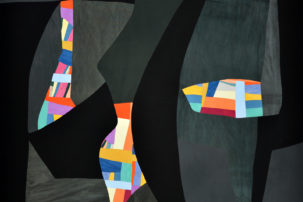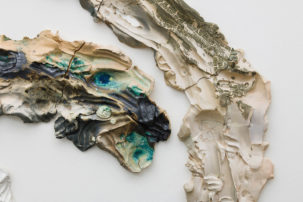There’s not too many people out there who love Toronto potholes.
But Christian Kliegel turned that civic negative into an artistic positive in Plot Holes, his installation at Canadian Art’s booth for Art Toronto.
The concrete weights at the base of the installation are cast from potholes in Kliegel’s west-end neighbourhood, as well as from ones in Kensington Market, where he works.
Part of the pothole casting was an effort to bring a bit of Toronto into the fair; another part was to connect with a city where the artist has only recently moved with his family.
“Being in Toronto, I wanted to find something that made me explore the city,” Kliegel says.
“The bricks come from Leslie Spit,” he notes, too. In the installation, pieces of debris from that East End industrial-landfill-turned-nature-reserve hold down tabletops and corners. “I was fascinated by [the bricks]. I think a lot of people recognize them here, as but it was completely new to me.”
The idea of “local materials” comes through in a different way—hyperlocally, perhaps—in Kliegel’s use of hollow steel pipe as a vertical element in the piece. The environment of the Metro Toronto Convention Centre itself provided the inspiration for that.
In talking about that silvery pipe element in Plot Holes, Kliegel points to the galvanized steel trusses running across the top of many art-fair booths at the convention centre.
“I knew that was one material I wanted to work with,” Kliegel says of the steel trusses, “and I started thinking how could I stand them up.”
The result is an installation that, for me, has a precarious, lo-fi feel, and seems to subvert the typically pristine art-fair booth setup.
Gravel and aggregate is scattered on the concrete floor, in parts, while unfinished pine lumber strips provide the rest of the structure’s framework. The walls are painted dark grey, an almost dirtlike tone, rather than gleaming white.
“I wasn’t really interested in having it be a completely rectilinear space,” Kliegel says. “I like the idea that it kind of breaks out, takes it away from that grid.”
Kliegel’s sensitivity to site and space was honed during his studies in architecture at the University of British Columbia, which followed a degree in art from Emily Carr University.
“It opened a lot of doors in public art and working with artists on large-scale projects,” Kliegel says of his architecture studies. “That interest in scale and the gallery space really shaped my practice in a certain direction.”
In this setting, Kliegel’s work accentuates, for me, what a temporary thing an art-fair environment is—after all, it goes up and down completely in under a week, walls included. And while, at first glance, an art fair usually seems solid and tangible, full of well-lit gallery-like booths, it really is a structure that exists for just a moment in time, until the next trade show takes hold of the space.
That’s my reading, though. When I ask Kliegel about working in an art-fair context, the only challenge he said he had was setting up in a noisy environment filled with activity, rather than in a quiet gallery all to himself.
And after all, I reflect, aren’t most human urban structures—from pothole-cratered roadways to old brick buildings—temporary, too? That’s not a temporal condition limited to art commerce, for sure.
There is one note on context that Kliegel wants to elaborate on before we part—and that is the context of being commissioned to make work for Canadian Art’s booth in particular.
As part of a response to that context, Kliegel went through the magazine’s archives and pulled issues that had a personal resonance for him: magazines that reminded him of places he has lived, or of important influences. These editions are laid out upon one of the structures in Plot Holes; together, they depict Frank Gehry, B.C. Binning, Calgary, Vancouver, Toronto and many other personalities and places.
“I feel like it really turned into a kind of collaborative element,” Kliegel says of the magazine covers. “That became an important part of it.”
Christian Kliegel’s Plot Holes can be viewed at Canadian Art’s booth at Art Toronto, which runs October 27 to 30 at the Metro Toronto Convention Centre.

 Christian Kliegel's Plot Holes at Canadian Art's booth for Art Toronto 2017. Photo: Kaari Sinnaeve.
Christian Kliegel's Plot Holes at Canadian Art's booth for Art Toronto 2017. Photo: Kaari Sinnaeve.






